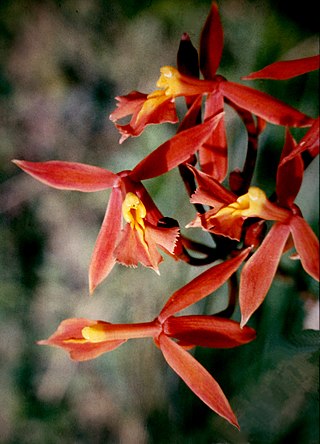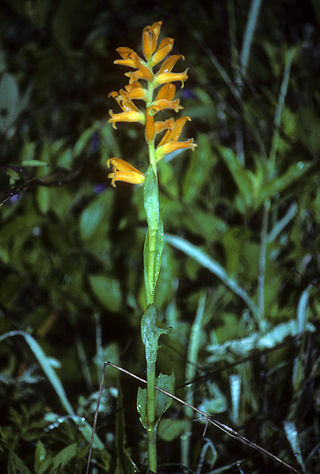
Orchids are plants that belong to the family Orchidaceae, a diverse and widespread group of flowering plants with blooms that are often colourful and fragrant. Orchids are cosmopolitan plants that are found in almost every habitat on Earth except glaciers. The world's richest diversity of orchid genera and species is found in the tropics.

Bulbophyllum is a genus of mostly epiphytic and lithophytic orchids in the family Orchidaceae. It is the largest genus in the orchid family and one of the largest genera of flowering plants with more than 2,000 species, exceeded in number only by Astragalus. These orchids are found in diverse habitats throughout most of the warmer parts of the world including Africa, southern Asia, Latin America, the West Indies, and various islands in the Indian and Pacific Oceans. Orchids in this genus have thread-like or fibrous roots that creep over the surface of trees or rocks or hang from branches. The stem is divided into a rhizome and a pseudobulb, a feature that distinguished this genus from Dendrobium. There is usually only a single leaf at the top of the pseudobulb and from one to many flowers are arranged along an unbranched flowering stem that arises from the base of the pseudobulb. Several attempts have been made to separate Bulbophyllum into smaller genera, but most have not been accepted by the World Checklist of Selected Plant Families.

Oncidium, abbreviated as Onc. in the horticultural trade, is a genus that contains about 330 species of orchids from the subtribe Oncidiinae of the orchid family (Orchidaceae). As presently conceived, it is distributed across much of South America, Central America, Mexico and the West Indies, with one species (O. ensatum) extending into Florida. Common names for plants in this genus include dancing-lady orchid and golden shower orchid.

Trichocentrum, often abbreviated Trctm in horticulture, is a genus in the orchid family, Orchidaceae. Dancinglady orchid is a common name for plants in this genus. It was described by Stephan Ladislaus Endlicher and Eduard Friedrich Poeppig in 1836. This genus alone makes up the monogeneric Trichocentrum alliance, a quite distinct lineage of the subtribe Oncidiinae.

Cattleya is a genus of orchids from Costa Rica south to Argentina. The genus is abbreviated C in trade journals.

The Orchidoideae, or the orchidoid orchids, are a subfamily of the orchid family (Orchidaceae) that contains around 3630 species. Species typically have a single (monandrous), fertile anther which is erect and basitonic.

Epidendroideae is a subfamily of plants in the orchid family, Orchidaceae. Epidendroideae is larger than all the other orchid subfamilies together, comprising more than 15,000 species in 576 genera. Most epidendroid orchids are tropical epiphytes, typically with pseudobulbs. There are, however, some terrestrials such as Epipactis and even a few myco-heterotrophs, which are parasitic upon mycorrhizal fungi.

Catasetinae is a subtribe within the Orchidaceae and contains 8 genera. Its members are widespread in lowland tropical Central and South America up to 1,500 meters. They are found on trees, stumps or old fence posts.

Cyrtopodium cristatum is a species of orchid native to South America.

Dichromanthus is a genus of flowering plants from the orchid family, Orchidaceae. As currently delimited, it is monophyletic and includes four species:
- Dichromanthus aurantiacus(Lex.) Salazar & Soto Arenas - much of Mexico, south to Honduras
- Dichromanthus cinnabarinus(Lex.) Garay - from Texas to Guatemala
- Dichromanthus michuacanus(Lex.) Salazar & Soto Arenas - from Texas and Arizona south to Honduras
- Dichromanthus yucundaaSalazar & García-Mend. - Oaxaca

Eltroplectris, the long-claw orchid, is a genus of flowering plants from the orchid family, Orchidaceae. It is native to South America, the West Indies, and Florida.
- Eltroplectris assumpcaoanaCampacci & Kautsky - Brazil
- Eltroplectris brachycentronSzlach. -Bolivia
- Eltroplectris calcarata(Sw.) Garay & H.R.Sweet - Florida, Bahamas, Cayman Islands, Cuba, Hispaniola, Jamaica, Puerto Rico, Windward Islands, Trinidad, Suriname, Venezuela, Colombia, Peru, Brazil, Paraguay
- Eltroplectris cogniauxiana(Schltr.) Pabst - Brazil
- Eltroplectris dalessandroiDodson - Ecuador
- Eltroplectris janeirensis(Porto & Brade) Pabst - Brazil
- Eltroplectris kuhlmanniana(Hoehne) Szlach. & Rutk. in P.Rutkowski, D.L.Szlachetko & M.Górniak - Brazil
- Eltroplectris longicornu(Cogn.) Pabst - Brazil
- Eltroplectris macrophylla(Schltr.) Pabst - Brazil
- Eltroplectris misera(Kraenzl.) Szlach. - Brazil
- Eltroplectris rossiiDodson & G.A.Romero - Ecuador
- Eltroplectris schlechteriana(Porto & Brade) Pabst - Brazil, Argentina, Paraguay
- Eltroplectris triloba(Lindl.) Pabst - Brazil, Argentina, Paraguay
Helonoma is a genus of flowering plants from the orchid family, Orchidaceae. It includes 4 known species, all native to South America.
- Helonoma americana(C.Schweinf. & Garay) Garay - Venezuela, Ecuador
- Helonoma bifida(Ridl.) Garay - Venezuela, Guyana, Brazil
- Helonoma chiropterae(Szlach.) Carnevali & G.A.Romero in G.A.Romero & G.Carnevali - Venezuela
- Helonoma peruviana(Szlach.) Salazar, H.C.Dueñas & Fern.Alonso - Colombia, Peru

Lankesterella is a genus of flowering plants from the orchid family, Orchidaceae. It is found mostly in South America, with a few species extending north into Cuba, the Dominican Republic and Costa Rica.
Nothostele is a genus of flowering plants from the orchid family, Orchidaceae. It contains two known species, both endemic to Brazil.
Palmorchis is a genus of flowering plants from the orchid family, Orchidaceae. It is native to South America, Central America and Trinidad.
- Palmorchis caxiuanensisRocha, S.S.Almeida & Freitas - Pará
- Palmorchis colombianaGaray - Colombia
- Palmorchis deceptoriusVeyret & Szlach. - Colombia
- Palmorchis duckeiHoehne - Brazil
- Palmorchis eidaeDressler - Costa Rica
- Palmorchis guianensis(Schltr.) C.Schweinf. & Correll - Brazil, Venezuela, the Guianas
- Palmorchis imuyaensisDodson & G.A.Romero - Ecuador
- Palmorchis lobulata(Mansf.) C.Schweinf. & Correll - French Guiana, Ecuador, Peru
- Palmorchis nitidaDressler - Costa Rica, Panama
- Palmorchis pabstiiVeyret - French Guiana
- Palmorchis paludicolaDressler - Costa Rica
- Palmorchis pandurataC.Schweinf. & Correll - Ecuador
- Palmorchis powellii(Ames) C.Schweinf. & Correll - Costa Rica, Panama
- Palmorchis prospectorumVeyret - French Guiana, Suriname
- Palmorchis puber(Cogn.) Garay - Brazil, Venezuela
- Palmorchis pubescentisBarb.Rodr. - French Guiana, Suriname, Brazil, Venezuela, Trinidad
- Palmorchis silvicolaL.O.Williams - Costa Rica, Ecuador
- Palmorchis sobralioidesBarb.Rodr. - Ecuador, Brazil
- Palmorchis sordidaDressler - Costa Rica
- Palmorchis trilobulataL.O.Williams - Nicaragua, Costa Rica, Panama, Suriname, Ecuador
- Palmorchis trinotataDressler - Panama
Galeottiella is a genus of flowering plants from the orchid family, Orchidaceae. Traditionally it had been included in subtribe Spiranthinae, but following molecular phylogenetic and morphological studies it is now placed in a subtribe on its own, Galeottiellinae.

Prescottia is a genus of flowering plants from the orchid family, Orchidaceae. It is widespread across much of Latin America and the West Indies, with one species (P. oligantha) extending into Florida.

Sarcoglottis is a genus of flowering plants from the orchid family, Orchidaceae. It is widespread across much of Latin America from Mexico to Argentina, with one species extending northward into Trinidad and the Windward Islands.
Leslie Andrew Garay, born Garay László András, was an American botanist. He was the curator of the Oakes Ames Orchid Herbarium at Harvard University, where he succeeded Charles Schweinfurth in 1958. In 1957 he was awarded a Guggenheim Fellowship.

Habenaria repens, commonly called the water-spider bog orchid or the floating orchid, is an orchid species widespread across Latin America from Mexico and the West Indies south to Argentina, as well as in the Southeastern United States from Texas and Oklahoma east to Florida and the Carolinas plus an isolated population in Virginia.















